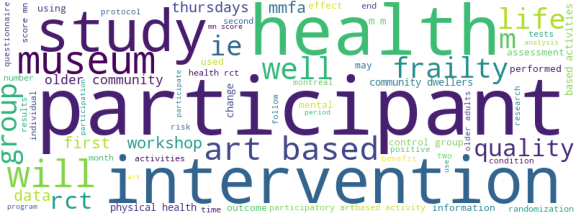| Id | 699 | |
| Author | Beauchet O., Cooper-Brown L., Hayashi Y., Galery K., Vilcocq C., Bastien T. | |
| Title | Effects of thursdays at the Museum at the Montreal Museum of Fine Arts on the mental and physical health of older community dwellers: The art-health randomized clinical trial protocol | |
| Reference | Beauchet O., Cooper-Brown L., Hayashi Y., Galery K., Vilcocq C., Bastien T.; Effects of thursdays at the Museum at the Montreal Museum of Fine Arts on the mental and physical health of older community dwellers: The art-health randomized clinical trial protocol ;Trials vol:21 issue: 1.0 page: |
|
| Link to article | https://www.scopus.com/inward/record.uri?eid=2-s2.0-85089617125&doi=10.1186%2fs13063-020-04625-3&partnerID=40&md5=af1ffef9a4b1d142cdd0d527be5169b2 |
|
| Abstract | Background: Recently, we demonstrated that the Montreal Museum of Fine Arts (MMFA) participatory art-based activity, known as Thursdays at the Museum,improved the well-being, quality of life, and physical health (i.e., frailty) of older community dwellers by using a pre-post intervention, single arm, prospective and longitudinal experimental design. The present randomized clinical trial (RCT), known as the Art-Health RCT (A-Health RCT), aims to compare changes in well-being, quality of life, frailty, and physiological measures in older community dwellers who participate in Thursdays at the Museum(intervention group) and in their counterparts who do not participate in this art-based activity (control group). Methods/design: The current unicenter, randomized, clinical, controlled, comparative trial recruits 150 older community dwellers to two parallel arms (75 participants in the intervention group and 75 participants in the control group). The intervention is a 3-month cycle of weekly Thursdays at the Museum,which are structured 2-h-long art-based workshops performed in a group setting at the MMFA. The control group is composed of participants who do not take part in art-based activities, receive their usual health and/or social services, and commit to report any other activity practiced during the same time. Assessments of the primary outcome (well-being) and the secondary outcomes (quality of life, frailty, and physiological measures including heart rate, daily step count, sleep duration, and its phases) are performed on six occasions: at baseline, at the beginning of the second and third months, at the end of the third month, as well as 6 and 12 months after the last workshop. Statistical analyses are performed with the intention to treat and per protocol. Comparisons of changes in outcome measures between intervention and control groups use repeated measures tests. Discussion: Art-based activities carried out at museums have been receiving increased interest from researchers and policy-makers because of their benefits to mental and physical health. There are few robust studies, such as RCTs, that focus on older community dwellers or assess the efficacy of these participatory museum activities. The A-Health RCT study provides an opportunity to confirm the benefits of a participatory art-based museum activity on the elderly population and to show the key role played by museums in public health promotion. Trial registration: NCT03679715; Title: A-Health RCT: Effects of Participatory Art-Based Activity on Health of Older Community Dwellers; First posted date: September 20, 2018; prospectively registered. © 2020 The Author(s). |
|
| Keywords | Art; Health; Museum; Older adults; Quality of life; Randomized controlled trial; Well-being |
Wordcloud:



